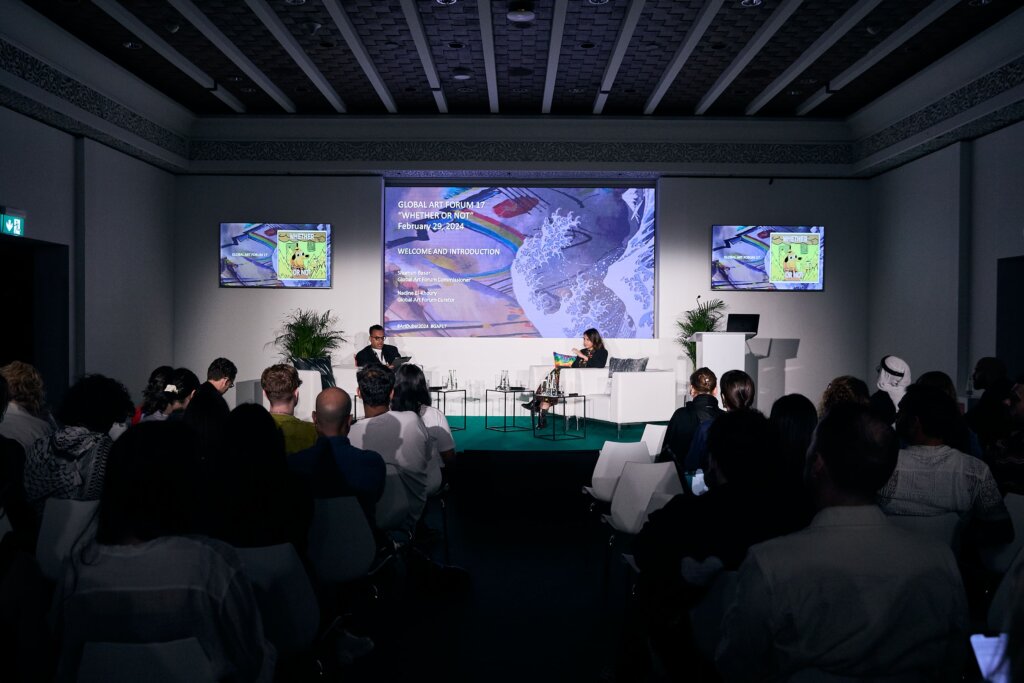One of Art Dubai’s key trends was the intersection between craft and contemporary art, explored across a number of galleries from the MENASA region to Latin America. Craft and folk idioms are not new to the art world, and their local roots have furnished many important political layers, as in Dickens Otieno’s tapestry of shredded aluminium cans or Catalina Swinburn’s folded and woven archaeological papers, which comment on the power of ancestral geography in diasporas. But what happens if these works are taken formally: as material-led investigations into geometry?

Rachid Koraichi, Algeria, 1947, A Montagne aux Etoiles 20, 2021
Courtesy of AICON ART
New York
Each craft – from ceramics to glass blowing and textile and fabric art – is based on its materiality, and the artworks in this year’s contemporary section of the fair followed suit. The quilting of fabrics created a patchwork of structured squares in Iranian artist Fereydoun Ave’s collection From Shah Abbas and his Page Boy (2017), at Dastan Gallery. In contrast were the curves and loops of embroidery curving freely across the fabric in Peruvian artist Jose Luis Martinat’s El Milagro Económico I (2017), at VIGIL GONZALES Galería.

From “Shah Abbas and his Page Boy” collection, 2017
Courtesy of DASTAN BASEMENT
Iran
Another introduction was imitation: As if in conversation between medium and message, artists deceived onlookers with their ability to utilise new ways of creating patterns through unpredictable mediums. In Dana Awartani’s recreation of Islamic geometry (in Untitled, 2021, at Athr Gallery) the Jeddah-based artist utilizes gouache paints to recreate the symmetry and opacity of traditional wood. Waqas Khan, who trained at the National College of Art in Lahore and exhibits at Galerie Krinziger, creates non-images – precisely rendered monochrome artworks that involve, he says, a performance of painting inspired by Sufi mysticism. Khan creates primarily monochrome compositions Elena Damiani’s As the Dust Unsettles no. 1 (2020), at Selma Feriani, seemed to consist of marble or granite – but in fact was painted with watercolour to imitate dust storms as seen by telescopes in space, as the Lima artist effects a transition from technology to craft. Rashid Koraichi’s A Montaigne au Etoile 20 (2021), at Aicon Gallery, resembles intricate silver beading on blue silk; it is in fact acrylic on canvas. The message became not about the intricacy of the geometry or the subtlety of curves, but about the medium that hosts and creates shapes and symbolic structures – a focus on the material itself that showed how these works are embedded in their environmental surroundings, cultural heritage, or contemporary pop culture.

Dana Awartani, Saudi Arabia, 1987, Untitled, 2021
Courtesy of ATHR
Saudi Arabia
Examples of this trompe l’oeil facility ran across the fair, from earlier works to later ones, as artists challenged the ways in which craft and geometry can be read. In the series of three-dimension objects that comprised Gossip / Janus (2021), Martin Soto Climent at Andréhn-Schiptjenko stretched layers of non-sheer violet stockings tights across the four sides of a frame. He creates what looks like the work of a cubist painter with an extraordinary eye for depth, balancing this high-art reference alongside the intimacy of the suggested body. Within these works, a larger dialogue between mediums took place: Subterfuge, imitation and homage became new crafts in themselves.

Martín Soto Climent, Gossip Janus, 2021
Courtesy of ANDRÉHN-SCHIPTJENKO
Stockholm/Paris
AWA Cohort Impressions of Art Dubai 2022
By Reem Farah









